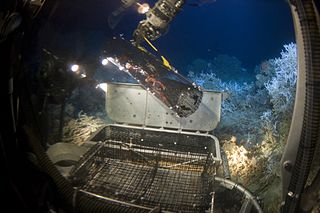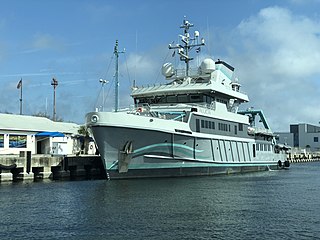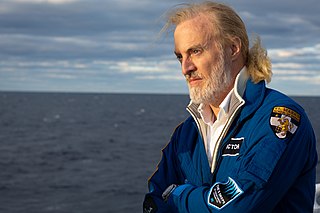
The Challenger Deep is the deepest known point of the seabed of Earth, located in the western Pacific Ocean at the southern end of the Mariana Trench, in the ocean territory of the Federated States of Micronesia. According to the GEBCO Gazetteer of Undersea Feature Names the depression's depth is 10,920 ± 10 m (35,827 ± 33 ft) at 11°22.4′N142°35.5′E, although its exact geodetic location remains inconclusive and its depth has been measured at 10,902–10,929 m (35,768–35,856 ft) by deep-diving submersibles, remotely operated underwater vehicles, benthic landers, and sonar bathymetry. The differences in depth estimates and their geodetic positions are scientifically explainable by the difficulty of researching such deep locations.

The Mariana Trench is an oceanic trench located in the western Pacific Ocean, about 200 kilometres (124 mi) east of the Mariana Islands; it is the deepest oceanic trench on Earth. It is crescent-shaped and measures about 2,550 km (1,580 mi) in length and 69 km (43 mi) in width. The maximum known depth is 10,984 ± 25 metres at the southern end of a small slot-shaped valley in its floor known as the Challenger Deep. The deepest point of the trench is more than 2 km (1.2 mi) farther from sea level than the peak of Mount Everest.

A bathyscaphe is a free-diving, self-propelled deep-sea submersible, consisting of a crew cabin similar to a Bathysphere, but suspended below a float rather than from a surface cable, as in the classic Bathysphere design.

A submersible is an underwater vehicle which needs to be transported and supported by a larger watercraft or platform. This distinguishes submersibles from submarines, which are self-supporting and capable of prolonged independent operation at sea.

Milwaukee Deep, also known as the Milwaukee Depth, is part of the Puerto Rico Trench. Together with the surrounding area, known as Brownson Deep, the Milwaukee Deep forms an elongated depression that constitutes the floor of the trench. As there is no geomorphological distinction between the two, it has been proposed that the use of both names to refer to distinct areas should be reviewed.

A deep-submergence vehicle (DSV) is a deep-diving crewed submersible that is self-propelled. Several navies operate vehicles that can be accurately described as DSVs. DSVs are commonly divided into two types: research DSVs, which are used for exploration and surveying, and DSRVs, which are intended to be used for rescuing the crew of a sunken navy submarine, clandestine (espionage) missions, or both. DSRVs are equipped with docking chambers to allow personnel ingress and egress via a manhole.

The Puerto Rico Trench is located on the boundary between the Caribbean Sea and the Atlantic Ocean. The oceanic trench, the deepest in the Atlantic, is associated with a complex transition between the Lesser Antilles subduction zone to the south and the major transform fault zone or plate boundary, which extends west between Cuba and Hispaniola through the Cayman Trough to the coast of Central America.

USNS Indomitable (T-AGOS-7) was a United States Navy Stalwart-class ocean surveillance ship in service from 1985 to 2002. From 2003 until 18 June 2014, she was in commission in the National Oceanic and Atmospheric Administration (NOAA) as the oceanographic research ship NOAAS McArthur II. As of 2018 it serves as a mother ship now named the Deep Submersible Support Vessel (DSSV) Pressure Drop for the crewed deep-ocean research submersible DSV Limiting Factor.

Deep-sea exploration is the investigation of physical, chemical, and biological conditions on the ocean waters and sea bed beyond the continental shelf, for scientific or commercial purposes. Deep-sea exploration is an aspect of underwater exploration and is considered a relatively recent human activity compared to the other areas of geophysical research, as the deeper depths of the sea have been investigated only during comparatively recent years. The ocean depths still remain a largely unexplored part of the Earth, and form a relatively undiscovered domain.

The Sirena Deep, originally named the HMRG Deep, was discovered in 1997 by a team of scientists from Hawaii. Its directly measured depth of 10,714 m (35,151 ft) is third only to the Challenger Deep and Horizon Deep, currently the deepest known directly measured places in the ocean. It lies along the Mariana Trench, 200 kilometers to the east of the Challenger Deep and 145 km south of Guam.

Jiaolong is a Chinese crewed deep-sea research submersible that can dive to a depth of over 7,000 metres (23,000 ft), developed from the Sea Pole-class bathyscaphe. It has the second-greatest depth range of any crewed research vehicle of the Chinese Navy; the only crewed expeditions to have gone deeper were the dives of the Trieste bathyscaphe in 1960, Archimède in 1962, Deepsea Challenger in 2012, and DSV Limiting Factor in 2019.

Deepsea Challenger is a 7.3-metre (24 ft) deep-diving submersible designed to reach the bottom of the Challenger Deep, the deepest-known point on Earth. On 26 March 2012, Canadian film director James Cameron piloted the craft to accomplish this goal in the second crewed dive reaching the Challenger Deep. Built in Sydney, Australia, by the research and design company Acheron Project Pty Ltd, Deepsea Challenger includes scientific sampling equipment and high-definition 3-D cameras; it reached the ocean's deepest point after two hours and 36 minutes of descent from the surface.
DeepFlight Challenger is a one-person submersible built with the intention of reaching the Challenger Deep, utilizing DeepFlight technology from Hawkes Ocean Technologies. The submersible is owned by Virgin Oceanic.

MV Odyssey is a 56-meter research and exploration vessel that facilitates a wide range of diving, submersible and aerial operations. The ship has recently been used by OCEEF, under the name Alucia and was previously utilized by initiative OceanX for ocean exploration, research and filming missions. She is now on Charter to the InkFish group and going into refit shortly.

Larry Connor is an American real estate and technology business person, as well as a private astronaut certified by NASA. Connor is the head of the Connor Group, a real estate investment firm located in Dayton, Ohio.

Victor Lance Vescovo is an American private equity investor, retired naval officer, sub-orbital spaceflight participant, and undersea explorer. He was a co-founder and managing partner of private equity company Insight Equity Holdings from 2000-2023. Vescovo achieved the Explorers Grand Slam by reaching the North and South Poles and climbing the Seven Summits. He visited the deepest points of all of Earth's five oceans during the Five Deeps Expedition of 2018–2019.
OceanX is an ocean exploration initiative founded by Mark Dalio and Ray Dalio, founder of investment firm Bridgewater Associates, an initiative by Dalio Philanthropies, OceanX is a “mission to explore the ocean and bring it back to the world. OceanX combines science, technology and media to explore and raise awareness for the oceans and “create a community engaged with protecting them.” The initiative also supports and facilitates ocean research for scientists, science institutions, media companies and philanthropy partners.

Striver bathyscaphe is a type of deep-submergence vehicle built in the People's Republic of China (PRC). It was built by China State Shipbuilding Corporation (CSSC). It can accommodate three crew members, and is designed to reach depths of more than 10,000 meters. Striver is equipped with two mechanical arms, seven underwater cameras, seven sonars, hydraulic drills, and other scientific devices.

Limiting Factor, known as Bakunawa since its sale in 2022, is a crewed deep-submergence vehicle (DSV) manufactured by Triton Submarines and owned and operated since 2022 by Gabe Newell’s Inkfish ocean-exploration research organization. It currently holds the records for the deepest crewed dives in all five oceans. Limiting Factor was commissioned by Victor Vescovo for $37 million and operated by his marine research organization, Caladan Oceanic, between 2018-2022. It is commercially certified by DNV for dives to full ocean depth, and is operated by a pilot, with facilities for an observer.

















